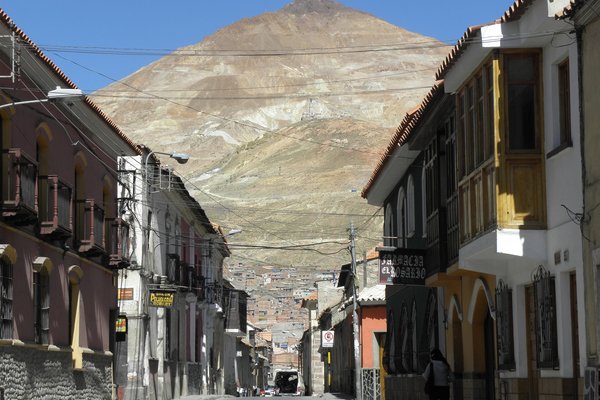Bolivia
Potosi
The City of Potosí comprises an urban and industrial landscape shaped by one of the major silver mines of modern times.
Dating from the 16th century and still in use, the site shows the whole production chain (including dams, smelters and ore-grinding mills) and its social context in the colonial city center. Its architecture and arts, using a baroque style incorporating Indian influences, have been influential across the Central Andes. It delivered so much silver to Spain that it resulted in major economic change.
Community Perspective: La Casa de la Moneda (the former Mint) is now the main attraction in the city. Our reviewers have mixed opinions on taking an underground tour of Cerro Rico mine; arguments pro are given by Michael Anak Kenyalang and some of those against by Timonator. Potosí can best be visited as a day trip from Sucre, as the combination of dust, dirt and altitude makes it not a very pleasant place to stay.
Site Info
Official Information
- Full Name
- City of Potosí (ID: 420)
- Country
- Bolivia
- Status
-
Inscribed 1987
Site history
History of Potosi
- 2014: In Danger
- uncontrolled mining operations, instability and risk of collapse of the Cerro Rico
- 1987: Inscribed
- Inscribed
- In Danger
- uncontrolled mining operations, instability and risk of collapse of the Cerro Rico Since 2014
- Type
- Cultural
- Criteria
- ii
- iv
- vi
Links
- UNESCO
- whc.unesco.org
- Official
-
- bolivia-online.net — Bolivia Online Potosi
All Links
UNESCO.org
- whc.unesco.org — whc.unesco.org/
Official Website
- bolivia-online.net — Bolivia Online Potosi
News Article
- July 20, 2015 bbc.com — Protesters cut access to Bolivian city of Potosi
- Oct. 12, 2014 nytimes.com — For Miners, Increasing Risk on a Mountain at the Heart of Bolivia's Identity
- July 27, 2014 channelnewsasia.com — Hundreds of human skeletons found in Potosi
- May 10, 2014 america.aljazeera.com — Project to reinforce Cerro Rico's mountaintop
- Aug. 13, 2010 worldtravelwatch.com — Protesting miners trapped some 100 foreign tourists for a week in Potosi
Community Information
- Community Category
- Urban landscape: Colonial
- Secular structure: Mines
Travel Information
Recent Connections
-
Perfect Inscriptions
1987 -
UNESCO Intangible Cultural Heritage Lists
Ch'utillos, the Festival of San Bartolo… -
On beer cans and bottles
Cerro Rico on Potosina beer bottleSee u…
Connections of Potosi
- Individual People
-
-
Mapped or Illustrated by Blaeu
On top frieze of "Americae nova tabula" (1617)See luna.folger.edu
-
Charles V
first called "Villa Imperial de Carlos V"
-
- Geography
-
-
Highest cultural WHS
4,090 metres -
Andes
"perched at an altitude of 4,000 m in the icy solitude of the Bolivian Andes" (OUV)
-
- Trivia
-
-
Fatal Accidents or 'disasters'
Cerro Rico: 19 and 20 deaths from mining accidents in 2009 and 2010 respectively -
Total Solar Eclipse since Inscription
3 November, 1994 -
On beer cans and bottles
Cerro Rico on Potosina beer bottleSee untappd.com
-
Built or owned by Spanish
Potosí became an 'Imperial City' following the visit of Francisco de Toledo in 1572. It and its region prospered enormously following the discovery of the New World's biggest silver lodes in the Cerro de Potosí south of the city. The major colonial-era supplier of silver for Spain, Potosí was directly and tangibly associated with the massive import of precious metals to Seville (AB ev)
-
- Ecology
-
-
Liquid Mercury
Became a massive producer of Silver because of the transport of Mercury from Huancavelica - The "Patio Process" of silver amalgamation replaced the previous method of extracting silver from its ore by smelting but required mercury at the rate of 2 to 1 unit of silver production. "Colonial cinnabar mining and refining began in Huancavelica, Peru, in 1564. With a local source of mercury, the amalgamation process was adopted to refine silver in Potosí, Bolivia, in the early 1570s..According to our calculations, between 1564 and 1810, an estimated .....39,000 metric tons were released as (mercury) vapor during silver refining operations in Potosí."
-
- World Heritage Process
-
-
First inscriptions
Bolivia 1987 -
Slow Starters
1976-1987 : 11 years -
Perfect Inscriptions
1987
-
- Religion and Belief
-
-
Mercedarians
Iglesia Na Sa de la Merced "The Order of Mercy was expanding very rapidly and during the sixteenth century, it established convents in .. Potosí (1549) .."See orderofmercy.org
-
Cathedrals
Cath Bas de Nstra Senora de la Paz
-
- Human Activity
-
-
Silver production
-
Mummies
Several young children, displayed in La Moneda -
Cuzco School of Painting
Works by Tito, Bitti and others -
Slavery
"To compensate for the diminishing indigenous labor force, the colonists made a request in 1608 to the Crown in Madrid to begin allowing for the importation of 1500 to 2000 African slaves per year. An estimated total of 30,000 African slaves were taken to Potos? throughout the colonial era. African slaves were also forced to work in the Casa de la Moneda as ac?milas humanas (human mules). Since mules would die after couple of months pushing the mills, the colonists replaced the four mules with twenty African slaves." -
Mints
La Moneda, a mint established in 1672 to coin the silver. The WHS is also explicitly linked to the economic change brought in the 16th century by the flood of Spanish currency resulting from the massive import of precious metals.
-
- Constructions
-
-
Aqueduct
"industrial monuments of the Cerro Rico, where water is provided by an intricate system of aqueducts and artificial lakes"
-
- WHS on Other Lists
-
-
Memory of the World
Documentary Fonds of Royal Audiencia Court of La Plata (2011) contains the history of silver mining in Potosí; Secular Town Council of Potosí (1585-1817) contains council records (2025)See www.unesco.org
-
UNESCO Intangible Cultural Heritage Lists
Ch'utillos, the Festival of San Bartolomé and San Ignacio de Loyola, the meeting of cultures in PotosíSee ich.unesco.org
-
- Timeline
-
-
Built in the 16th century
It owes its prosperity to the discovery, between 1542 and 1545, of the New World's biggest silver lodes
-
- Science and Technology
-
-
Mines which can be visited underground
Silver. Cerro Rico (walk in/out)
-
- Literature & Film
-
-
History of the World in 100 objects
No 80. Pieces of Eight 1589-98 ADSee www.bbc.co.uk
-
News
- bbc.com 07/20/2015
- Protesters cut access to Bolivian …
- nytimes.com 10/12/2014
- For Miners, Increasing Risk on a M…
- channelnewsasia.com 07/27/2014
- Hundreds of human skeletons found …
Recent Visitors
Visitors of Potosi
- Adrian Turtschi
- Alejandro Lau
- Alexander Parsons
- Ammon Watkins
- Andrew0181
- Angela Vandyck
- Anna Wludarska
- Argo
- Atila Ege
- Bamse
- basementonline
- Bill Maurmann
- Bram de Bruin
- Carlos Sotelo
- Chantal den Haan
- chiuliqi
- Christravelblog
- Cirene Moraes
- Claire Bradshaw
- Crinion
- CynthiaSam
- Daniela Hohmann
- Delphine Delaunay
- edstar500
- Els Slots
- emvcaest
- Erik Jelinek
- Fan Yibo
- Feldhase
- Fernweh
- Filip Murlak
- Francky D'Hoop
- Gernot
- giloudepuertorico
- Harry Mitsidis
- headventure
- hotpickle
- Iain Jackson
- Ingrid
- Jacob Otten
- Jarek Pokrzywnicki
- Jens
- J_neveryes
- Joel on the Road
- JoStof
- KateY
- Kevin247
- Krijn
- La Concy
- Lameduck99
- Loic Pedras
- Lucio
- Luis Filipe Gaspar
- Lukasz Palczewski
- Maciej Gil
- marcel staron
- Mariam
- Michael Ayers
- Michael Novins
- Mikan22
- Monica66
- Morodhi
- nan
- natlefebvre@hotmail.
- Niall Sclater
- Nihal Ege
- Palimpsesto
- Patrik
- Pchxiao
- Philipp Leu
- Pieter Dijkshoorn
- Pink Bunny
- Reza
- Roman Bruehwiler
- Sandmann15
- Sergio Arjona
- Shandos Cleaver
- sibariam
- Ssong.x
- Stanislaw Warwas
- stephanvermeulen
- Tcchang0825
- Tevity
- Thomas Buechler
- Thomas van der Walt
- Tim Allen
- Timonator
- Walter
- Weecheng
- Xiquinho Silva
- zfish
- Zoë Sheng
Community Reviews
Show full reviews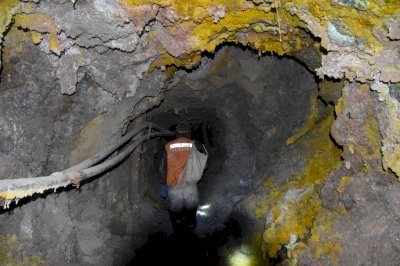
It was already dark as my bus from Tupiza entered Potosi's bus terminal, a busy place where ticket sellers' loud sales announcements reverberated around the circular hall like monks' chants. The scene outside the bus terminal was even less impressive with busy traffic and vernacular buildings. First impressions of Potosi were not great.
Once the taxi entered the historic part of the city, however, the mood - both mine and the city's - changed. I remember how seeing the columns of Plaza 6 de Agosto being illuminated by lights made me feel happy. Going for a walk in the night, I found areas that were peacefully calm but also areas that were lively with people going out for drinks (or bubble tea) or had a musical parade going through it.
During the day, I discovered a hardworking city with Andean Baroque architecture and overhanging covered balconies. Potosi's engaging colonial buildings and preserved history makes it more worthy as a two or more days destination rather than a day trip stop.
With respect to the mine tour of Cerro Rico, I did go on it. In the tour was just me and a Belgian tourist. The other tourist - a man probably in his late 20s - had a lot of difficulty breathing and keeping up and decided to quit the tour about a 1/3 way into it, which meant that I was left alone in the dark mine while the guide accompanied the other tourist out (I …
Keep reading 0 comments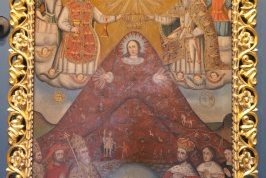
During my four and a half days in Potosí I used only 2 days to actually visit the city. 2 days I was waiting with my girlfriend that her headaches would go away. She was blaming the cold and dry air during the nights at 0°C, I suspected rather the altitude of 4000 m that Potosí has. Anyhow the two non- consecutive days passed by and during the other two days we were able to visit the mint, the St. Theresa monastery, do a touristic bus tour through the city, visit some other churches from the outside or sneak peak into the service and watch a first league football match of Nacional Potosí on a really high level ;). The last half day I waited in the hostel for my girlfriend who participated in a tour visiting the mines of Cerro Rico which I decided against even though parts of them logically belong to the story of the WHS. Working in a Western European Utility for whole of my working life I didn't dare to visit a workplace of others that surely would be shut down or run completely differently in the hands of my former employer in terms of respect to the workers and their safety. She found the visit interesting however had a really bad guide and knows more about the mines from reading now than from her actual visit which surely shows a tough environment however doesn't obviously display all the malconditions of the working place environment. …
Keep reading 0 comments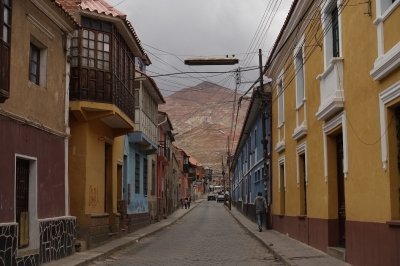
Getting to Potosi had been a dream of mine ever after having visited some of the silver mines of Mexico. Potosi was the largest silver mine of the Spanish empire and its crown jewel. To this day "Vale un Potosi" is a standing expression in Spanish for "worth a fortune".
The Potosi mine was a gruesome place. The high altitude of the mine at 4000m made the already terrible working conditions of a 16th century mine even worse. Similar to other parts of the Americas they tried using African slaves, but they tended to die off too quickly in the high altitude. So the work was mostly done by the local native Americans.
To this day the Potosi mines are a pretty dangerous places for miners. And for visitors. So you should consider if you want to join a tour. I decided against it and spent my time visiting the old town. The most notable structure in town is the royal mint, the casa de la moneda. I would recommend joining a tour to get a feeling for the site and the silver processing.
Personally, I enjoyed the Mexican silver towns better. Potosi is a historically important site and deserves inscription. It just isn't the nicest example of the type of town. And it lacks the quirkiness of my personal highlight, Guanjuato.
Getting There
I came by bus from Uyuni having also ticked off Pulancayo (T). If you …
Keep reading 0 comments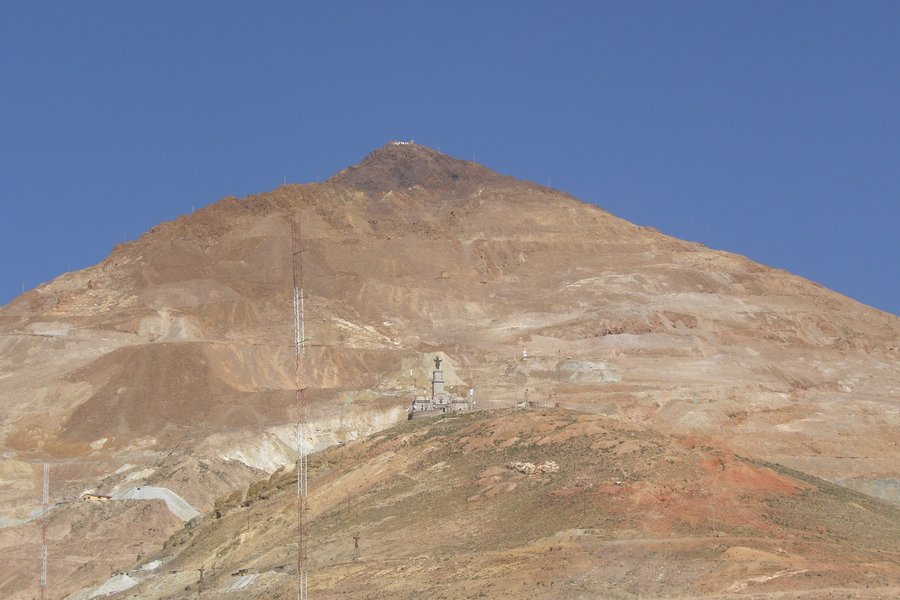
You have to join a tour to get into the mines of Cerro Rico. When I got to the assembly point I was told that the other tourists that were supposed to join the group didn't show up (heard that they were drunk, LOL) so it left only me in the tour. Even it's only me but the tour still kept on, so I was like a VIP. We got into a small van and went to a place to suit up. We were provided with a helmet with a torchlight, hand gloves, boots, a thin jacket and pants. Then we went to the miners' market. As the 3rd generation miner and an ex-miner, my guide Antonio explained well to me about the history of Cerro Rico and the real miner story of himself on the way to the market.
When we arrived at the miners' market, we bought some water and coca leaf for the miners. Since it's one on one, Antonio told me a lot of extra things about the usage of coca leaf for the miners, like how they could work whole day with just eating coca leaf and how to heal themselves with coca leaf.
We went to see the city of Potosi and Cerro Rico as background at the mirador (lookout point) Then the journey into the mine tunnel started. Since I was the only one, Antonio brought me to his former working place Minas de San Miguel. It's a bit different from the touristic …
Keep reading 0 comments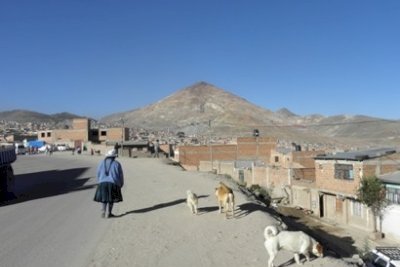
The approach to Potosí is magnificent - the road from Sucre already is a fine drive of 2.5 hours mostly on the Altiplano, but the first sight of the Cerro Rico (where all Potosi's riches came from) is truly exciting. There have been reports over the last few years that it is in danger of collapsing totally because of over-mining, but it still seemed to be a very sturdy mountain to me. It completely dominates the compact city beneath it.
As in Sucre, opening hours to the sights of Potosi are fairly limited and unreliable. I had left Sucre early to be able to visit at least its main attraction - La Casa de la Moneda. This former Mint is now set up as a museum, displaying both parts of its former use and miscellaneous exhibitions on art, archeology, and geology. One of its prize pieces is the 18th century La Virgen del Cerro, a work of the Potosi school depicting the whole (partly mythical) story of the Cerro Rico.
I had decided against visiting the interior of one of the mines early on - too claustrophobic for me. So I just wandered about in the fine colonial city center, sat on its main square, visited the bright Santa Teresa Monastery, and even meandered into the outskirts of the city to have a look at one of the former smelters, the Ingenio San Marcos.
Knowing the city's history, it's an impressive place to visit. Though as with …
Keep reading 0 comments
As a Bolivian I am so proud that Potosi has been declared a World Heritage site. At the height of its splendor it is said to have rivaled London, Paris and Madrid in it's population size. It is also written that for some religious procesion the streets where paved with silver ingots that just poured out of "Cerro Rico" and which later where exported to Spain.
Many of us have forgotten or do not know about the past glory this little city high in the Andes has brought our country. It is truly a world heritage site. It would be wonderful to be able to access more infomation on it, to be able to see the art and read more of the stories about the ostentation the families of the miners lived. Almost like the bubble lived here in the US by the IPO generation :)
Keep reading 0 comments
